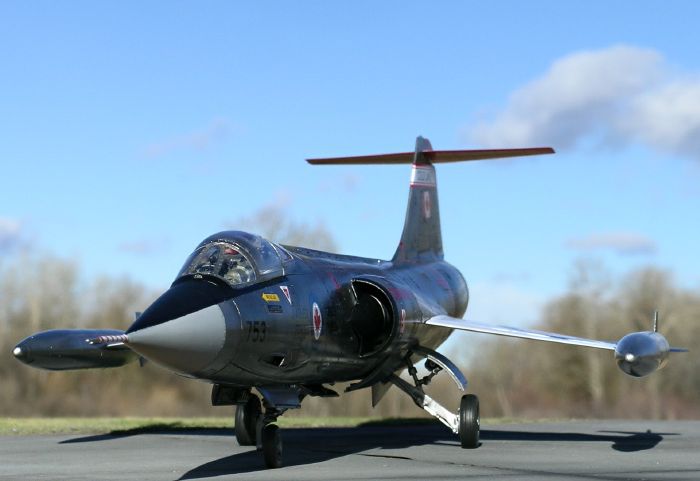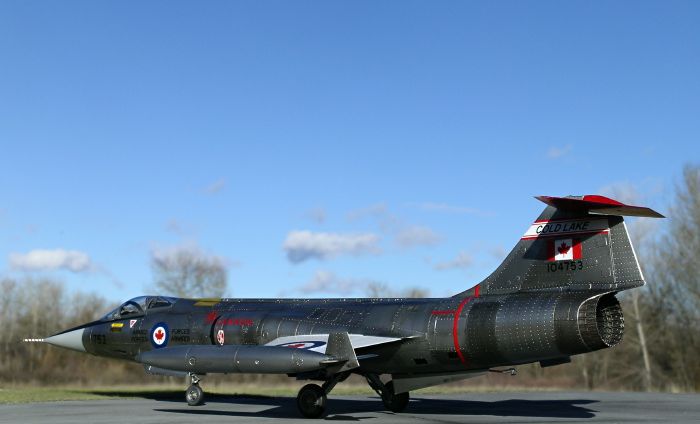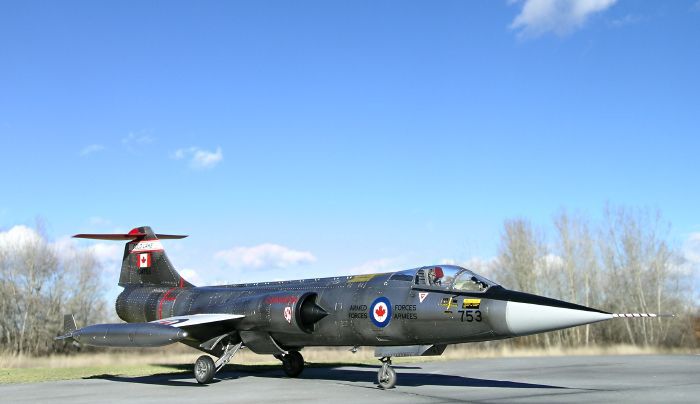|
Hasegawa's 1/48 scale
CF-104
Starfighter
by
Ian Robertson
|
 |
|
CF-104 Starfighter |

Hasegawa's 1/48 scale
F-104G Starfighter is available online from Squadron.com
In 1959 Canada chose the Lockheed F-104 Starfighter to replace the
aging fleet of Canadair Sabres. Initially the CF-104 (built under
license by Canadair) was intended as a low-level nuclear weapons
delivery system for NATO in the event of a European conflict with the
Soviet Union. Later its role shifted to that of a conventional strike
weapon. The CF-104 remained in RCAF/CAF service until 1986, at which
time it was replaced by the CF-18 Hornet. More than half of the Canadian
Starfighter fleet was lost in accidents during its 27 year operational
career. Many of these losses were due to the starfighter’s dangerous
operational role as a fast low-level flier, often in poor weather
conditions. My model depicts a CF-104 trainer from 417 Squadron, Cold
Lake (Alberta), 1975.
The Model
I used Hasegawa’s 1/48 F-104J Starfighter as the basis for my model.
Additions included a Black Box CF-104 cockpit set and Aires resin
exhaust nozzle. Both resin sets fit well and were beautifully detailed.
Decals are from Belcher Bits decal sheet #6.
The model was simple and straightforward to build, taking only a
couple of evenings to complete. I built and painted the model in
subassemblies (fuselage, wings, wing tanks, horizontal stabilizers) to
minimize the need for masking.

The Black Box CF-104 cockpit set fit well in the model once the
raised detail on the fuselage sidewalls was removed. I painted the
cockpit medium grey as outlined in Hasegawa’s paint instructions. Online
reference photos of the C-2 seat were used as a color guide for the
resin seat and harnesses.
The fuselage exterior was first sprayed with Tamiya fine grey surface
primer and then polished with micromesh sanding cloths. I painted the
nose cone with a mixture of light ghost grey and neutral grey (Polly
Scale acrylic) and then masked it off until the natural metal finish had
been applied. The metal finish was achieved using various shades of
Alclad II (duraluminum, dark aluminum, steel, polished aluminum)
followed by washes of Tamiya black acrylic to help tone down the shine
from the rivets and panel lines.
The upper wings were painted in with Tamiya white primer, whereas the
undersides were painted the same as the nose cone. The horizontal
stabilizers were painted with Tamiya red acrylic.

The upper and lower wing surfaces were given a light misting of Future
as a gloss coat prior to the addition of the decals. No gloss coat was
used over the natural metal finish. A coat of Polly Scale clear satin
was applied over the wings and elevators once decals had been applied. A
satin clear coat was applied directly over the larger decals only on the
fuselage. I did not clear coat over the stencils.
Photographs were taken outdoors in natural sunlight with a Nikon
Coolpix 5400 digital camera. The “unsharpen mask” tool of Adobe
Photoshop was used to restore some of the clarity and crispness lost
during image compression.
The rivets on the model are exaggerated in the photographs due to the
sun reflecting from them. Under less intense light conditions the rivets
are far less conspicuous and distracting. This is one of the most
heavily riveted models I have built by Hasegawa, and I wish they had
been a little more refined in their approach.

Nevertheless, the model was fun to build and a nice diversion from my
regular WWII fare.
Click on the thumbnails
below to view larger images:
Messerschmitt Bf 109
Modelling Manuals 17 |
|
|
|
|
US Price: $17.95
UK Price: £12.99
Publisher:
Osprey Publishing
Publish Date:
January 25, 2002
Details: 64 pages; ISBN: 1841762652 |
|
|
Model, Images and Text Copyright ©
2006 by Ian Robertson
Page Created 26 March, 2006
Last Updated 26 March, 2006
Back to HyperScale
Main Page
|
Home
| What's New |
Features |
Gallery |
Reviews |
Reference |
Forum |
Search